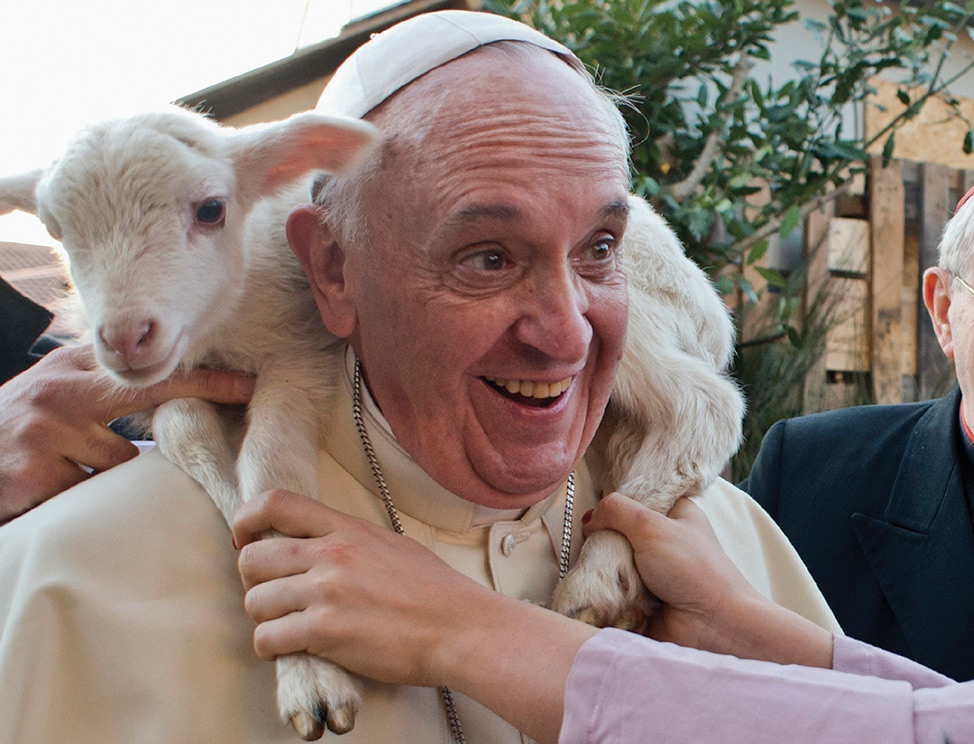
Pope Francis, like the “Good Shepher” in Scripture, carries a lamb on his shoulders. He was visiting the Roman parish of St Alphonsus Maria de Lihuori on January 6, the Feast of the Epiphany, to see an enormous living manger scene 200 parishioners were participating in. The Pope spoke personally with each one of the 200, embracing and blessing them.
Pope Francis is scheduled to make his second major foreign trip during 2014. From May 24 to 26, he will travel to the Holy Land, to the places where Jesus walked… His message will be a message of peace.
In this issue, we take a look back at 2013 as we present our “Top Ten People” of the year, examples of Christian courage and charity for our world. At the same time, in this space, we would like to look ahead at what the year 2014 may bring.
Pope Francis will begin the second year of his pontificate on March 13. Perhaps his most important appointment will be in May, when he will make the second great trip of his pontificate: to the Holy Land, from May 24 to 26 (the first was to Brazil last July for World Youth Day). Francis is following in the footsteps of Pope Benedict (in 2009), of Pope John Paul II (in 2000), and of Pope Paul VI (in 1964, exactly 50 years ago.)
In 1964, Paul met with and embraced the Greek Orthodox Ecumenical Patriarch Athenagoras in Jerusalem. On that occasion, the two mutually lifted the excommunications pronounced against the heads of each others Churches in 1054 A.D., nearly 1,000 years ago. So that meeting was historic, and gave hope for progress toward eventual reunion.
In this sense, ecumenism, improved relations between the Catholic, Latin West and the Orthodox, Greek East (the “two lungs” of the Christian faith, in the striking metaphor of Pope John Paul II, who repeatedly called for the “two lungs” to “breathe together”) will be a central concern of this upcoming papal trip.
But the trip will have at least two other great purposes: (1) to reach an agreement with the State of Israel, after 20 years of negotiation, on Catholic properties and taxation in Israel (the ambassador of Israel to the Holy See, Zion Evrony, said on January 8 that “the negotiations on the economic and financial accord are finally reaching a conclusion; let us hope that the accord will soon be signed.”); and (2) to speak out for a just peace in the Middle East, peace especially for the threatened Christians of the region.
The trip to the Holy Land, however, is not the only important item on the agenda of Pope Francis in 2014.
He will create new cardinals on February 22 (he was expected to reveal their names around the middle of January).
In the week preceding that Consistory, from February 17-19, Francis will participate in the third meeting of the Council of Cardinals (the group of eight cardinals from the five continents whom he has appointed to assist him in the reform of the Roman Curia). This body is drafting a plan for the “substantial” reform of the Roman Curia. After that meeting, the Pope will attend a much larger “plenary assembly” of all the cardinals (February 20-21), to focus on issues that will be discussed at next October’s Synod of Bishops on the family. (That Synod is expected to address, among other topics, the pastoral care of divorced and remarried Catholics.) After the February 22 Consistory, Francis will participate in a plenary meeting of the Council of the Synod. That gathering will weigh the results of the worldwide consultation on the family and, on the basis of this input, will prepare the Working Document for the October synod.
On March 5, Francis will issue his Lenten message and preside at the Ash Wednesday ceremony. He will then preside at the Holy Week ceremonies, beginning on Palm Sunday (April 13) and ending on Easter Sunday (April 20). On the following Sunday, April 27, he will canonize Blessed John XXIII (Pope from 1958-63) who opened the Second Vatican Council, and Blessed John Paul II, who led the Church from 1978 to 2005. He will declare them saints in St. Peter’s Square on “Divine Mercy” Sunday; the ceremony could attract 1 million pilgrims.
“The People’s Pope,” as Time magazine dubbed him, will then go to the Holy Land in May. He will visit Jordan, Israel and Palestine, and join the Ecumenical Patriarch of Constantinople, Bartholomew I, in Jerusalem, to commemorate the 50th anniversary of the historic encounter between Pope Paul VI and Patriarch Athenagoras in 1964.
As happened in 2013, Francis is unlikely to hold public audiences in July and August. He does not take holidays, however, and will probably remain at the Domus Sanctae Marthae all summer.
The first Jesuit Pope in the history of the Church, who once wanted to go as a missionary to Japan, has his eyes fixed on Asia, the continent where two-thirds of the world’s population lives but where Christians count for a minority 3%, and Catholics 2%. He wishes to share the Good News of Jesus with the many Asian peoples who do not yet know Him. Benedict XVI did not visit Asia, but Francis is on record as saying that he intends to do so. Many Asian Church leaders say they expect him to make his first visit to their continent in the second half of 2014. He has received several invitations, including from the Philippines, Korea, Japan, and Sri Lanka. But no announcement about any such Asian trip has yet been made.


Facebook Comments